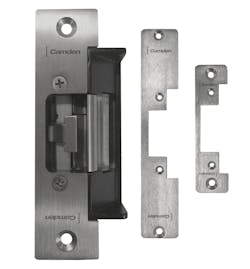Electric strikes are cost-saving devices designed to manually and automatically lock and unlock doors on demand. When used in conjunction with a manual means of release, they enable someone in authority to allow access to a building or an office from a remote location, often in conjunction with an intercom and/or video camera. This saves steps, and thus non-productive time. Automatic uses for an electric strike usually center on a connection with an electronic access control system or a stand-alone access device such as an electronic combination lock. To enter, the individual requesting access must present a valid access credential, such as a key fob, radio transmitter, or an access card.
Electric strikes are found in almost every security application. One example is the real-time control of an inner office door by a receptionist behind a window or desk. To release the door, he or she merely has to press a button on or under her desk. Another example is where employees enter a workplace through a common door equipped with a card reader.
“Electric strikes are the main ingredient in every access control system we install whether it’s a commercial building or the administration wing of a correctional facility,” says John Larkin, senior partner with Electronic Systems Consultants LLC, an electronics security firm in Columbus, Ohio. “We depend on a local locksmith or door hardware company to install our electric strikes because they do this kind of work every day. They know what they’re doing.”
In this Locksmith Ledger article, we’ll discuss how electric strikes work, how to install them, and how and where to sell them. We’ll follow up with information on new and improved models as well as a list of manufacturers that make and offer electric strikes in general.
The Nature of the Electric Strike
Technology wise, electric strikes are electromechanical devices which mean they combine both electrical and mechanical properties. Most electric strikes are designed with a movable keep that prevents the lock’s latch from moving, thus preventing the door from opening. A solenoid or electromagnet inside the strike is used to unlock the keep by way of electromagnetism.
From a specification standpoint, electric strikes come in two basic electrical configurations--intermittent (fail-secure) and continuous duty (fail-safe). Each one must comply with local fire codes. For example, Section 21.9 entitled Electrically Locked Doors of NFPA 72, 2013 Edition (National Fire Code [NFC]), specifies that “Electrically locked doors in a required means of egress shall unlock in the direction of egress where required by other laws, codes, and governing standards.” In other words, an electric strike can prevent someone from entering a building, but it cannot stop them from exiting.
“We use continuous-duty electric strikes whenever we can because they are not subject to rigorous fie code oversight, which means we do not have to connect them to a local fire alarm system within the building,” says Robert Kowal, president of Liberty Locksmiths of Apopka, Fla. “We like them better than electromagnetic locks (EMLs) because they are subject to a local AHJ (Authority Having Jurisdiction) who often requires egress motions, a manual means of egress, like a push-to-exit device across the door, and a fire alarm connection.”
Continuous-duty electric strikes (fail-safe) operate in such a manner that a door will automatically unlock when power is removed or fails. With power applied the door is locked and when it’s taken away it will unlock. Removing power from the door can be achieved by a momentary normally-closed push button switch or an access control system in conjunction with a relay connected to a power supply. When a connection to a local fire alarm system is required by the local AHJ, another relay can be used that connects to the fire alarm system, but in this case the relay must be installed in close proximity to the door and the wiring between that relay and the fire alarm panel as well as the relay coil must be monitored.
An intermittent-duty, or fail-secure model acts in the opposite manner. These electric strikes lock the door when power is absent and then unlocks it when power is applied. In many cases, where a lockset is used in classroom mode, nothing else is usually required, providing that the lever on the lock meets with local fire code.
Installing an Electric Strike
Installation of an electric strike begins with an understanding of the release device and system that controls it. For example, what kind of voltage do you need? Is there a power supply or transformer on site that will provide it? Is this a security application or merely pedestrian traffic control? Is it to be installed on an inside or outside door? What kind of door lock is there on the door now, if any? Is it to be subject to an access control system? All of these factors and more have a bearing on the electric strike you choose.
Most electric strikes are convertible, meaning they will accept 12VDC or 24VDC where some use 16.5VAC. Many times, the same strike will provide fail-safe and fail-secure operations. These electric strikes also come with multiple faceplates, either as part of the assembly or for purchase separately, which means you need to know the type of door lock and door frame in use.
In truth, all of the answers to these questions can be derived by conferring with the individual in charge of grounds, perhaps an on-site access control firm, or the door hardware company supplying the doors. You can also get advice from suppliers who stock a wide variety of electric strikes, but make sure you choose a firm that has knowledgeable countermen who know and understand the needs of the locksmith. Two in particular come to mind: Akron Hardware and Zipf Lock, but there are many others to choose from.
Installation is facilitated by the use of special jigs designed to attach to specific door frames for the purpose of routing out a space for a specific model electric strike. These jigs require the same router that you use to cut latch plates into doors and to perform other necessary procedures.
“Some of the access control companies out there who have trouble doing the more complicated things like routing in a metal door strike to accept an electric strike, will subcontract the work to a locksmith,” says Kowal.
To view a video of an HES 5000 electric strike installation, demonstrated by Kowal, go to Liberty Locksmith’s YouTube channel at http://bit.ly/23eVpt5.
Newly Introduced Electric Strikes
Here are a few newly released electric strikes on the market worth noting.
Camden Door Controls of Mississauga, ON Canada, recently released two Grade 1 universal electric strikes that provide a host of features that you are sure to enjoy. The CX-ED1079L is a low profile strike made for locks with a 5/8" latch projection and the CX-ED1079DL is designed for a 3/4" standard latch. Both are selectable 12/24V AC/DC and offer fail-safe/fail secure operation. Both are equipped with connectors as well as horizontal faceplate/body adjustment and latch monitoring. For more information, call Camden at (877) 226-3369 or go to http://bit.ly/1OvKAAh.
Trine Access Technology of Bethel, Conn, also recently released a new member of the firm’s electric strike family. Made specifically for use with mortise locks, the 4100DBDL dual electric strike is designed to accommodate the mortise lock latch as well as the dead latch. Through independent control, it’s now possible to offer two levels of automated security, each one independent of each other.
“This dual strike is ideal for use in hospital bathrooms, school dormitories where the kids can have privacy but the RA has the authority to open both lock and dead latches, just in case something is going on and access to a room is immediately needed” says Fred .Orbeta, engineering manager with Trine.
For more information, visit www.trineonline.com.






